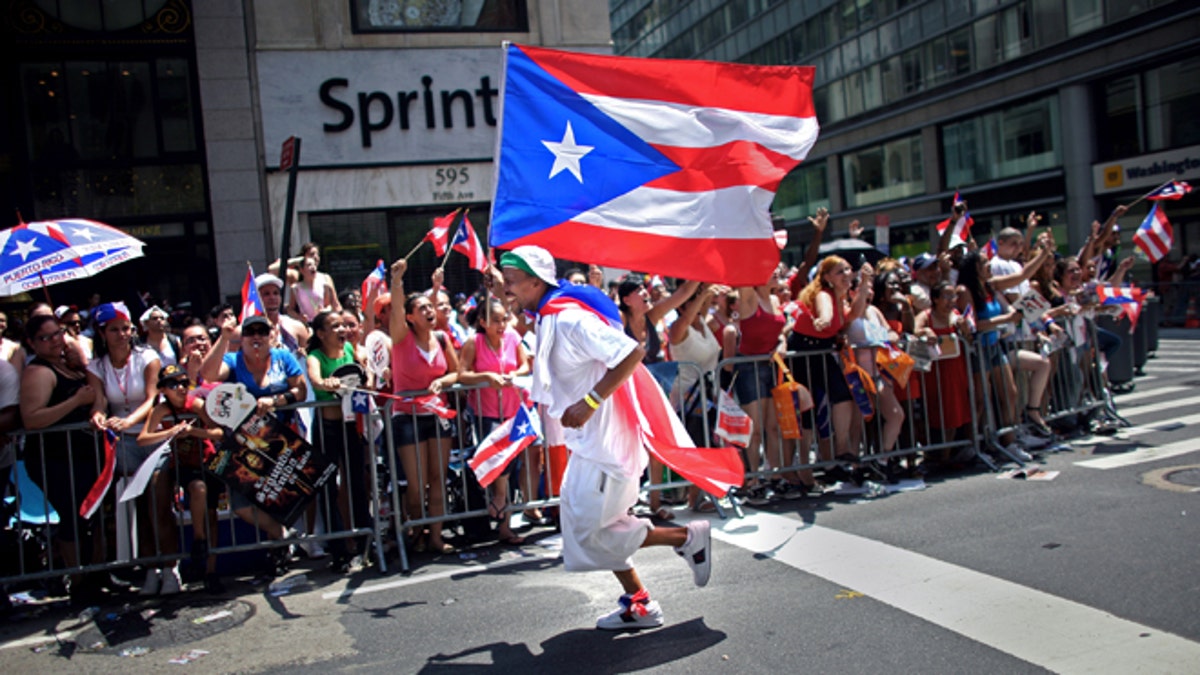
NEW YORK CITY - JUNE 8: A participant runs in front of the crowd with the Puerto Rican flag in the annual Puerto Rico Day Parade June 8, 2008 in New York City. The parade honoring Puerto Ricans is an annual New York City tradition and takes place along Fifth Avenue. (Photo by Yana Paskova/Getty Images) (2008 Getty Images)
WASHINGTON (AP) – The United States Census Bureau released data on Thursday showing that the Latino population is no longer the fastest-growing minority group in the country.
Non-Hispanic whites are still by far the largest racial group in the United States with a population of 197.8 million. (All other racial and ethnic groups make up 37 percent of the population, or 118.3 million.) But Asians, not Hispanics, were the fastest-growing group in 2013.
The country's Asian population rose by almost 2.9 percent to 19.4 million, an increase of about 554,000. That increase was fueled by immigration, which accounted for 61 percent of the population increase.
While Asians grew the fastest last year, Hispanics still are the second-largest ethnic group in the United States, making up 17.1 percent of the total population in 2013. The Hispanic and Latino population grew by 2.1 percent to more than 54 million, a rise fueled by natural increase, which accounted for 78 percent of the of the total population change.
Native Hawaiians had the second-highest rate of increase at 2.3 percent, while American Indians grew by 1.5 percent and blacks by 1.2 percent. Non-Hispanic whites grew by 0.1 percent during that same time period.
Census officials estimate that whites will no longer be the majority in the United States in 2043, when it is estimated that the total number of minorities will be more than the total number of whites.
In terms of diversity, California tops the list.
Census figures showed that California had the nation's largest number of non-Hispanic whites (15 million); Hispanics (14.7 million); Asians (6.1 million); and American Indians and Alaska natives (1.1 million). New York, meanwhile, had the largest number of blacks (3.7 million) and Hawaii had the largest number of native Hawaiians and other Pacific Islanders at 366,000.
The locations change when you look at the percentage of each race by state.
Maine had the largest share of whites at 94 percent; Alaska had the largest percentage of American Indians and Alaska natives at 19.4 percent; Hawaii — the nation's only majority-Asian state — had the largest share of Asians at 56.3 percent and native Hawaiians at 26.1 percent; Mississippi led the nation in blacks at 38.1 percent; and New Mexico led in Hispanics at 47.3 percent.
The Hispanic, black and white populations grew the fastest in Texas, which gained 213,000 new Latinos last year, 78,000 new blacks and 51,000 new whites. California had the largest numerical increase of Asians (142,000); American Indians and Alaska natives (13,000); and Native Hawaiians and other Pacific Islanders (7,000).
The median age for non-Hispanic whites was 42.9, while the median age for minorities was 30.5 years.
The aging baby boom generation helped inch up the median age in the United States last year from 37.5 years to 37.6 years, but seven states — Alaska, Hawaii, Montana, North Dakota, Oklahoma, South Dakota and Wyoming — actually became younger.
"We're seeing the demographic impact of two booms," Census Bureau Director John Thompson said. "The population in the Great Plains energy-boom states is becoming younger and more male as workers move in seeking employment in the oil and gas industry, while the U.S. as a whole continues to age as the youngest of the baby boom generation enter their 50s."
Williams County, N.D., which the Census Bureau called the center of the country's Bakken shale energy boom, had the largest decline in age in the United States, 1.6 years.
Energy production is one of the fastest-growing industries in the United States. The boom in the U.S. follows the use of new technologies, such as hydraulic fracturing and horizontal drilling, to tap oil and gas reserves.
The county with the highest median age was Sumter County, Florida, at 65.5. The county with the lowest median age was Madison, Idaho, at 23.1.
The Census Bureau said there were only 10 states that had more men than women in 2013: Alaska at 52.4 percent, North Dakota at 51.1 percent, Wyoming at 51 percent, Hawaii at 50.5 percent, Nevada at 50.4 percent, Utah at 50.3 percent, Colorado, South Dakota, and Montana at 50.2 percent and Idaho at 50.1 percent.
The states with the highest percentage of women were Delaware at 51.6 percent, Rhode Island at 51.6 percent, Massachusetts at 51.5 percent and Maryland at 51.5 percent. The District of Columbia had a higher percentage of women than all the states at 52.6 percent.
Follow us on twitter.com/foxnewslatino
Like us at facebook.com/foxnewslatino
